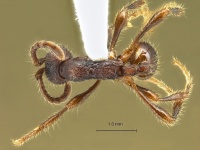Aenictus kutai
| Aenictus kutai | |
|---|---|

| |
| Scientific classification | |
| Kingdom: | Animalia |
| Phylum: | Arthropoda |
| Class: | Insecta |
| Order: | Hymenoptera |
| Family: | Formicidae |
| Subfamily: | Dorylinae |
| Genus: | Aenictus |
| Species: | A. kutai |
| Binomial name | |
| Aenictus kutai Jaitrong & Wiwatwitaya, 2013 | |
So far A. kutai is known only from the type locality in a lowland fire-damaged forest.
Identification
A member of the pachycerus group. Jaitrong & Wiwatwitaya (2013) - This species is closely related to Aenictus sulawesiensis and A. sp. 84 of WJT in having smooth and shiny lateral face of pronotum. However, it is easily separated from the latter two by its head and dorsal face of pronotum being entirely sculptured (partly smooth and shiny in the latter two).
Keys including this Species
Distribution
Borneo (E. Kalimantan)
Latitudinal Distribution Pattern
Latitudinal Range: 0.366666667° to 0.366666667°.
| North Temperate |
North Subtropical |
Tropical | South Subtropical |
South Temperate |
- Source: AntMaps
Distribution based on Regional Taxon Lists
Indo-Australian Region: Indonesia (type locality).
Distribution based on AntMaps
Distribution based on AntWeb specimens
Check data from AntWeb
Countries Occupied
| Number of countries occupied by this species based on AntWiki Regional Taxon Lists. In general, fewer countries occupied indicates a narrower range, while more countries indicates a more widespread species. |

|
Estimated Abundance
| Relative abundance based on number of AntMaps records per species (this species within the purple bar). Fewer records (to the left) indicates a less abundant/encountered species while more records (to the right) indicates more abundant/encountered species. |

|
Biology
Castes
Known only from the worker caste.
Nomenclature
The following information is derived from Barry Bolton's Online Catalogue of the Ants of the World.
- kutai. Aenictus kutai Jaitrong & Wiwatwitaya, 2013: 99, fig. 1A-C (w.) BORNEO (Indonesia: Kalimantan).
- Type-material: holotype worker, 9 paratype workers.
- Type-locality: holotype Indonesia: Borneo, Kalimantan, Kutai National Park, Teluk Kabah (0°22’N, 117°16’E), 19.ix.1993, SKY93-09-1 (Sk. Yamane); paratypes with same data.
- Type-depositories: MZBJ (holotype); BMNH, MHNG, SKYC, TNHM (paratypes).
- Distribution: Indonesia (Kalimantan).
Unless otherwise noted the text for the remainder of this section is reported from the publication that includes the original description.
Description
Worker
Holotype: TL 4.40 mm; HL 0.98 mm; HW 0.91 mm; SL 0.85 mm; ML 1.43 mm; PL 0.35 mm, CI 94; SI 93.
Paratypes (n = 9): TL 4.20-4.40 mm; HL 0.93-0.98 mm; HW 0.85-0.91 mm; SL 0.80-0.85 mm; ML 1.35-1.43 mm; PL 0.34-0.35 mm, CI 92–94; SI 93–94.
Head in full-face view oval, slightly longer than broad, with distinctly convex sides; posterior margin convex; occipital margin bearing a collar. Antennal scape relatively short, extending beyond 2/3 of head length but not reaching posterolateral corner of head; all funicular segments each longer than broad; terminal segment slightly shorter than VII+VIII+IX. Frontal carinae well developed, fused at the level of antennal base to form a single carina, extending slightly beyond the level of posterior margin of torulus. Parafrontal ridge well developed, extending 1/3 of head length (ca. 0.45 mm). Masticatory margin of mandible with large apical tooth, followed by 15-16 denticles of two sizes, the larger alternating with 1-3 smaller; basal margin with 1-2 very small denticles just behind basal tooth. Mesosoma stout; promesonotum (seen in profile) strongly convex dorsally, sloping gradually to metanotal groove; propodeum clearly lower than promesonotum, in profile its dorsal outline almost straight; mesopleuron clearly demarcated from metapleuron by a deep groove; upper portion of mesopleuron impressed; metanotal groove present but indistinct. Propodeal junction angulate, almost right-angled; declivity of propodeum shallowly concave, and encircled with a distinct rim. Petiole sessile, almost as long as high; its dorsal outline convex, posterior face of petiole shallowly concave, and encircled with a thin rim; subpetiolar process weakly produced below; its anteroventral corner bluntly angulate. Postpetiole slightly longer than petiole, its node slightly elevated posteriorly. Femora apically swollen.
Dorsum of head longitudinally but irregularly rugose, superimposed with dense minute punctures in anterior 2/3, densely and minutely punctate in posterior 1/3; sides of head densely and minutely punctate. Mandible densely striate except in apical portion and along masticatory margin. Antennal scape densely micropunctate. Punctation on dorsum of pronotum similar to that in posterior portion of dorsum of head; lateral face of pronotum with weaker sculpture, partly shiny; remainder parts of mesosoma irregularly and coarsely sculptured, superimposed with small punctures. Petiole and postpetiole densely punctate; dorsa with irregular longitudinal rugae. First gastral tergite and sternite smooth and shiny, except for the basalmost part with dense micropunctures. Basal 2/3 of femora microreticulate, but apically 1/3 superficially reticulate and shiny.
Head and mesosoma dorsally with dense standing hairs; longest pronotal hair 0.38–0.40 mm long. Head and mesosoma reddish brown; antenna, legs, petiole, postpetiole, and gaster reddish brown or yellowish brown. Typhlatta spot absent.
Type Material
Holotype worker from Indonesia, Borneo, E. Kalimantan, Kutai National Park, Teluk Kabah (0°22'N, 117°16'E), 19 Sep.1993, coll. Sk. Yamane, SKY93-09-1 (MZB). Nine paratype workers, same data as holotype (The Natural History Museum, Musee d'Histoire Naturelle Genève, SKY Collection, Natural History Museum of the National Science Museum).
Etymology
The specific name is a noun in apposition referring to the traditional name of a historic region in East Kalimantan Province of Indonesia.
References
References based on Global Ant Biodiversity Informatics
- Jaitron W., and D. Wiwatwitaya. 2013. Two new species of the Aenictus pachycerus species group (Hymenoptera: Formicidae: Aenictinae) from southeast Asia. The Raffles Bulletin of Zoology 61(1): 97-102.


